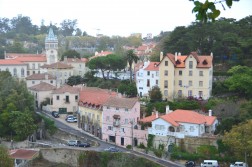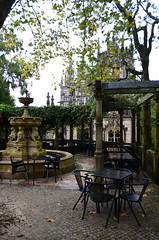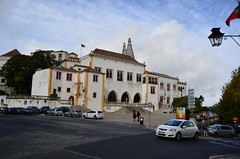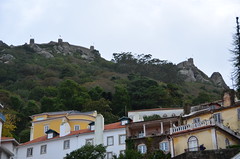
My friend Alex was kind enough to let me stay at his home in Cascais, about 30 minutes north of Lisbon, when I visited Portugal last November. Although I was thankful beyond words to have a free place to stay, I was less than inspired by my residential surroundings, views of the nearby North Atlantic notwithstanding.
Alex had to work my first full day in Portugal, so he drove me to nearby Sintra, a town whose pictureseque historical center dates back to the 19th century. Don’t let its location in the sterile suburbs fool you: Sintra is absolutely steeped in authentic Portuguese character.

The locations of historical attractions are clearly indicated everywhere in Sintra
History of Sintra
Although most of its historical buildings and sites only date back to the 19th century, evidence exists that Moors may have began urbanizing the area around Sintra as early as the 11th century. The Castle of the Moors, which sits atop the largest hill in Sintra, was built somewhere between the 8th and 9th centuries.
Beauty and charm aside, Sintra’s role in history isn’t as significant as one might think. This being said, one of the only major events of note to occur here — the Convention of Sintra — put an end to the French invasion of Portugal, which was admittedly pretty important.
Important Sintra Sites
While the entire historical center of Sintra has been designated as a UNESCO World Heritage site, make a point of seeing these sites when you visit, if you have time.

Take your time exploring Quinta da Regaleira
Quinta de Regaleira
The Quinta da Regaleira palace is located about a 10-minute walk from Sintra’s geographical center and was the first Sintra attraction I visited upon arrival in the town. Something of a cross between a garden, a vacation home and a castle, it isn’t shocking that the wealthy former owner of the site who commissioned the construction sought to create a bewildering, dreamlike world. You can easily spend an entire morning or afternoon here, so take your time exploring the site if you have it.

Use the Sintra National Palace as a point of reference, you explorations of it notwithstanding
Sintra’s Palaces
Sintra is home to several palaces, including Pena National Palace, Sintra National Palace, Monserrate Palace and Sateais Palace. If you’re a passionate history buff, information exists within each of these palaces explaining their significance, but for me, simply laying eyes upon the impressive architecture was enough. As you explore the town, you can use the bone-colored Sintra National Palace near the town’s historical center as a reference point if you get lost.

The Castle of the Moors overlooks all of Sintra
Castles of the Moors
Sintra is quite literally crowned by the Castle of the Moors, the 8th or 9th century structure I mentioned at the beginning of this article. Regrettably, I didn’t have the energy to scale the summit the castle sits atop — I’d been traveling for almost 10 weeks by the time I got to Sintra — but even if you just appreciate the castle from ground level, you’ll get the picture.

Sintra is dotted with beautiful buildings, regardless of their history, so you owe it to yourself to explore the town on foot
Getting to Sintra
Sintra is very much a city for walking, so even if you have a car, I recommend you using a train to get there. Otherwise, you may miss out on some of Sintra’s most subtle treasures, such as the cafés, gardens and statues that line its miles of shaded sidewalks. If you do drive, simply take the IC19 west from Lisbon.
To take a train from Lisbon to Sintra, take the Lisbon Metro to Rossio station, then board any train from Rossio in the direction of Sintra — Sintra is the terminus of the railway line you take, so you don’t have to look out for a specific stop. The journey costs just €1.40 each way and takes about 40 minutes.

Robert Schrader is a travel writer and photographer who’s been roaming the world independently since 2005, writing for publications such as “CNNGo” and “Shanghaiist” along the way. His blog, Leave Your Daily Hell, provides a mix of travel advice, destination guides and personal essays covering the more esoteric aspects of life as a traveler.








